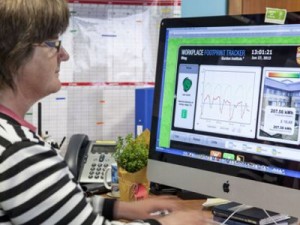 When Kathy Hilton, building facilities manager at The Gurdon Institute initiated an energy reduction programme, it opened the way for Lutron’s Energi TriPak retrofit lighting control solution that enabled the ‘unloved’ areas of the department to deliver significant energy savings.
When Kathy Hilton, building facilities manager at The Gurdon Institute initiated an energy reduction programme, it opened the way for Lutron’s Energi TriPak retrofit lighting control solution that enabled the ‘unloved’ areas of the department to deliver significant energy savings.
The University of Cambridge instigated an Energy and Carbon Reduction Project (ECRP) in 2010/11 and The Gurdon Institute was identified as one of five pilot departments due to its high energy consumption. As well as a behaviour change campaign, various energy savings technologies were looked at that would maximise savings, yet minimise disruption to the researchers or their work environment.
Kathy Hilton explains: “We wanted to reduce electricity consumption throughout The Gurdon Institute but we wanted to do this without affecting the ‘good science’ that is done here in developmental biology and cancer research. With this in mind, we challenged the researchers to get involved in an energy reduction competition. The key to keeping ‘switching off’ front of mind was to maintain a high profile of energy awareness and reminders. An iPad kiosk in the main entrance helped with this, as did various behavioural changes. We began to see great results, one lab in particular achieved electricity consumption reductions of 50%, without compromising their research, by a complete shift in behaviour; this involved planning usage of equipment in advance and leaving it switched off when not in use.
“However, as well as altering user behaviour to their surroundings, we still had a large number of spaces within the Institute that I termed ‘unloved’. These were the areas that were not the responsibility of any one person or research group and so energy consumption in these areas was not ‘owned’ by anyone. These areas involved a number of equipment rooms and general use laboratories.”
To see the impact that lighting control could have in ‘unloved’ areas, Kathy Hilton set up a trial in an equipment room; and a research laboratory. The results not only showed the significant savings that can be achieved when lighting is used well, but also the reductions that can be gained when the system is adapted to suit user habits.
Equipment room 323:
Energy monitoring and management company, Building Sustainability Ltd, installed Lutron’s Energi TriPak wireless retrofit solution in lab 323 that houses scientific equipment. This met Kathy Hilton’s classification of ‘unloved’ perfectly, as it had no ‘owner’ and individuals visited the room only sporadically throughout the day.
As well as one wireless Lutron Rania RF switch and two Radio Powr Savr wireless occupancy/vacancy sensors, in the 50m2 equipment room, Building Sustainability Ltd. also fitted a meter to monitor results. Thanks to the wireless nature of Lutron’s Energi TriPak solution, the retrofit was carried out with no disruption to the researchers’ working day and the existing T8 36W fluorescents remained in situ.
The electrical consumption used during a pre-specified sensor controlled period was then monitored and the sensor control was subsequently disabled and a period of manual light switching control was monitored. Using Building Sustainability’s Workplace Footprint Tracker system, the results showed that during the sensor controlled phase, an average of 6.45kWh was used per 24 hours and an average of 16.39 kWh was consumed when it was switched to manual control. This equated to a 60% reduction between manual switching and sensor control. Taking into account the cost of the Lutron Energi TriPak system, it was calculated by the students of the University of Cambridge that the equipment payback of the system would be achieved in approximately 1.5 years (at present energy costs).
Laboratory 328 Trial:
Following the success of the ‘unloved’ equipment room, the light control trial was expanded to include a laboratory. As well as occupancy sensors it was decided that daylight harvesting sensors be included. As well as installing Lutron’s EcoSystem Energy Savr Node addressable lighting control, four occupancy and daylight sensors and a tracking meter, the T8 36W fluorescents were also changed to lower energy T5 28W alternatives.
As previously, a sensor and manual time-frame were monitored however the early data results did not match Building Sustainability’s expectations. It was only on closer examination of the researchers’ working practices that the reason for this discrepancy was brought to light. The laboratory was using more electricity at the weekends when in ‘sensor control’ mode than in the manual mode.
Kathy Hilton explains: “The importance of taking into account occupant usage patterns was highlighted for us in lab 328. It was only when the data didn’t show the kind of energy savings that we expected that we explored further and found that the lab occupants were traditionally in the habit of leaving the lights off while working in the lab during weekend, whereas the sensors were automatically switching on the lights. As we had been encouraging behavioural changes for some time, the lab users had become used to only turning on lighting when they needed it, rather than doing it out of habit.”
With this in mind, the Lutron occupancy sensors were reset from presence detection to vacancy sensing, accommodating the lab researchers altered behaviour patterns. Combined with the daylight harvesting, lab usage went from 360 kWh (during the manual measurement period of already improved user lighting behavior) to 160 kWh following sensor re-programming. This equated to a 56% reduction between manual switching and sensor and daylight control. Taking into account the cost of the Lutron Energi TriPak system, it was calculated that payback of the system would be achieved in approximately 2 years (at present energy costs).
Expanding out the trial:
Following these successful trials, Kathy Hilton then worked with Building Sustainability to prepare an expansion programme to include the rest of the ‘unloved areas’ in The Gurdon Institute. George Bartley from Building Sustainability explains: “The lighting trials in equipment lab 323 and laboratory 328 gave us the measurements we needed to show the cost and environmental benefits of ‘loving the unlovely’ at The Gurdon Institute. Thanks to Lutron’s Energi TriPak retrofit solution, we have been able to show that significant lighting energy savings were possible, with no disruptions to the Institute or its researchers.”
The end result is that a further 97 zones, including research support and equipment rooms, stores, toilets and some small office areas have been retrofitted with Lutron’s light control solution since the trial’s completion earlier this year. Projected financial savings for these zones, based on the findings from the equipment room and lab trials, are as follows:
• £10,000 projected financial savings per annum
• 100,000 kWh electricity savings per annum
• 54 tonnes of carbon saved per annum
• Investment – £20,000 and payback – 2 years
Lutron’s Energi TriPak solution:
At The Gurdon Institute, Lutron’s Rania wireless RF switch and Radio Powr Savr wireless sensors: occupancy/vacancy sensors and daylight sensors were used. Lutron’s Energi TriPak solution provides easy to install, cost-effective, energy-saving retrofit light control in commercial spaces.
Lutron’s first retrofit solution, Energi TriPak consists of wireless transmitting devices that send out RF commands to load controllers that then switch, dim or integrate, depending on the information received. With no output wires and simple screw/adhesive mounts, Lutron’s Energi TriPak can reduce installation times by 70% over wired equivalents.

